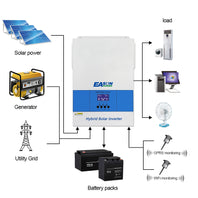When embarking on a solar panel DIY project, one of the most critical components to consider is the solar panel controller. The solar panel controller, also known as a charge controller, is responsible for regulating the voltage and current from the solar panels to the battery and preventing overcharging. In this article, we will explore the key factors to consider when choosing the best value solar panel controller for your DIY project.

Understanding the Basics
Before delving into the selection process, it's essential to understand the basic types of solar panel controllers available in the market. There are two main types: PWM (Pulse Width Modulation) and MPPT (Maximum Power Point Tracking). Each type has its advantages and is suitable for different applications. For instance, PWM controllers are more cost-effective, making them ideal for smaller DIY projects with limited budgets. On the other hand, MPPT controllers are more efficient and perform better in situations where there are temperature variations and shading issues.
Factors to Consider
When choosing a solar panel controller for your DIY project, several factors come into play. The first consideration is the maximum input voltage and current rating of the solar panels. It's crucial to select a controller that can handle the maximum voltage and current output of your solar panels to ensure optimal performance. Additionally, the battery voltage and type should be taken into account, as different controllers are designed for specific battery chemistries such as lead-acid, lithium, or gel.
Efficiency and Performance
Efficiency is a key factor when selecting a solar panel controller. MPPT controllers are known for their higher efficiency compared to PWM controllers, as they can track the maximum power point of the solar panels and convert excess voltage into additional current. This feature results in increased energy harvest, especially in low-light conditions. However, it's essential to weigh the cost of the controller against the potential increase in energy production to determine the best value for your DIY project.
Additional Features and Protections
Aside from the basic functionality of regulating the charging process, some solar panel controllers offer additional features such as temperature compensation, digital displays, data logging, and programmable settings. These features can enhance the overall user experience and provide valuable insights into the performance of the solar panel system. Furthermore, built-in protections against overcharging, short-circuiting, and reverse current flow are crucial for ensuring the safety and longevity of the battery and other system components.
Choosing the best value solar panel controller for your DIY project involves striking a balance between cost, efficiency, and the specific requirements of your solar panel system. By carefully evaluating the factors mentioned above and considering the long-term benefits, you can make an informed decision that aligns with your DIY project goals.